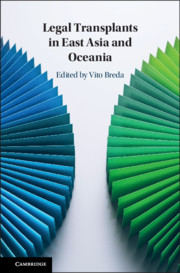Book contents
- Legal Transplants in East Asia and Oceania
- Legal Transplants in East Asia and Oceania
- Copyright page
- Dedication
- Contents
- Figures
- Tables
- Contributors
- Acknowledgements
- Table of Cases
- Table of Statutes
- Abbreviations
- Introduction
- Part I
- Part II
- 5 The Incomplete Legal Transplant – Good Faith and the Common Law
- 6 How Long Is Too Long to Determine the Success of a Legal Transplant? International Doctrines and Contract Law in Oceania
- 7 Proportionality in Australian Public Law
- 8 Legal Transfer and ‘Hybrid’ International Commercial Dispute Resolution Procedures: Lessons from the Singapore International Commercial Court
- 9 The Independent Lawyers’ Association of Myanmar as a Legal Transplant: Local Challenges to the Idea of an Independent National Bar Association
- Part III
- Index
- References
7 - Proportionality in Australian Public Law
from Part II
Published online by Cambridge University Press: 18 June 2019
- Legal Transplants in East Asia and Oceania
- Legal Transplants in East Asia and Oceania
- Copyright page
- Dedication
- Contents
- Figures
- Tables
- Contributors
- Acknowledgements
- Table of Cases
- Table of Statutes
- Abbreviations
- Introduction
- Part I
- Part II
- 5 The Incomplete Legal Transplant – Good Faith and the Common Law
- 6 How Long Is Too Long to Determine the Success of a Legal Transplant? International Doctrines and Contract Law in Oceania
- 7 Proportionality in Australian Public Law
- 8 Legal Transfer and ‘Hybrid’ International Commercial Dispute Resolution Procedures: Lessons from the Singapore International Commercial Court
- 9 The Independent Lawyers’ Association of Myanmar as a Legal Transplant: Local Challenges to the Idea of an Independent National Bar Association
- Part III
- Index
- References
Summary
Andrew Harding, in his excursus on ‘legal transplantation’, observed: ‘[W]e do live in a world of legal connectivity in which we share common problems which can only be addressed by a limited range of solutions which are unlikely not to have been tried before’. This prescient remark is apt in the context of the growing importance of the proportionality concept in the Australian public law arena. The proportionality concept attained particular prominence when the High Court of Australia found a freedom of political communication impliedly embedded in the Constitution. It was inevitable that with the establishment of such an implied fundamental constitutional guarantee, the High Court had to craft a principle to enable the saving or invalidation of legislation claimed to be in violation of the implied freedom.
- Type
- Chapter
- Information
- Legal Transplants in East Asia and Oceania , pp. 158 - 182Publisher: Cambridge University PressPrint publication year: 2019
References
XI Bibliography
Case Law
Australian Capital Television Pty Ltd v. Commonwealth [1992] HCA 45; (1992) 177 CLR 1.
Brown v. Tasmania [2017] HCA 43.
Commonwealth v. Tasmania (1983) 158 CLR 1,
Davis v. Commonwealth (1988) 166 CLR 79.
Marcus Clark & Co Ltd v. Commonwealth (1952) 87 CLR 177.
McCulloch v. Maryland 7 US 316 (1819).
McCloy v. NSW [2015] HCA 34.
Metropolitan Borough Council v. Secretary of State for Business, Innovation and Skills [2015] UKSC 6.
Minister for Aboriginal Affairs v. Peko-Wallsend (1986) 162 CLR 24.
Minister for Immigration and Citizenship v. Li 362 (2013) 249 CLR 332, 362 [63].
Minister for Resources v. Dover Fisheries Pty Ltd (1993) 116 ALR 54,
Monis v. The Queen [2013] 249 CLR 92.
Mulholland v. Australian electoral Commission (2004) 220 CLR 181.
Nationwide News Pty Ltd v. Wills [1992] HCA 46; (1992) 177 CLR 1
Re Fares Rural Meat and Livestock Corporation Pty Ltd v. Australian Meat and Live-Stock Corporation (1990) 96 ALR 153.
R v. Secretary of State for Foreign and Commonwealth Affairs, ex p Everett [1989] 1 QB
Tajjour v. NSW [2014] HCA 35.

